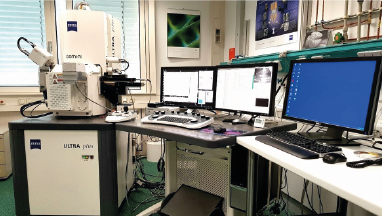PISA – ZEISS Ultra Plus Scanning Electron Microscope (SEM)
Contact:
Web:
Infrastructure belongs to:
The Field Emission-Scanning Electron Microscope of the Zeiss Ultra Plus allows you to capture, analyze and supplement high-resolution images to get total information out of your sample. The complete detection system of the Ultra Plus combines a high-tech Gemini FE-SEM column with various detectors: the Inlens & SE-Detector for high-resolution images, the inlens Energy selective Backscatter Detector (EsB) & Annular Backscatter Detector (AsB) for impressive material contrast of any samples, and Energy Dispersive Spectroscopy (EDS) for elemental analysis. We can use Ultra Plus in diverse scientific fields, including Materials and Geological Research: combined analytical procedures and retrieve of maximum amount of information from your sample and in Life Sciences to analyze samples easily with high throughput and get large volumes of data. Further, Ultra Plus also provides the option for analyzing biological specimen in natural state using Cryo attachment and Cathodoluminescence (CL) for mineralogical analysis.
Categories
Disciplinary Keywords
Instrumentation
Laboratory instrumentation
Instrument
-
Scanning Electron Microscope
The Scanning Electron Microscope (SEM) is one of the most versatile and widely used tools of modern science as it allows the study of both morphology and composition of biological and physical materials. By scanning an electron probe across a specimen, high resolution images of the morphology or topography of a specimen, with great depth of field, at very low or very high magnifications can be obtained. Compositional analysis of a material may also be obtained by monitoring secondary X-rays produced by the electron-specimen interaction. Thus detailed maps of elemental distribution can be produced from multi-phase materials or complex, bio-active materials. Characterization of fine particulate matter in terms of size, shape, and distribution as well as statistical analyses of these parameters, may be performed. There are many different types of SEM designed for specific purposes ranging from routine morphological studies, to high-speed compositional analyses or to the study of environment-sensitive materials. The Centre for Microscopy & Microanalysis presents three particular types of SEM that, in combination, provide a powerful analytical approach for many research or quality-control applications. Additional information available at "http://www.uq.edu.au/nanoworld/sem_gen.html" [Summary provided by The University of Queensland] (Source: Global Change Master Directory (GCMD). 2023. GCMD Keywords, Version 16.3. Greenbelt, MD: Earth Science Data and Information System, Earth Science Projects pision, Goddard Space Flight Center (GSFC) National Aeronautics and Space Administration (NASA). URL (GCMD Keyword Forum Page): https://forum.earthdata.nasa.gov/app.php/tag/GCMD+Keywords)
